This is a Suzuki Press Van, a medium format folding camera made by Suzuki Kōgaku Kōgyō K.K. in 1953. The Press Van is dual format, and can shoot both 6cm x 6cm images on 120 roll film and 24mm x 36mm images on 35mm film. This is the first version of the Press Van as a later model called the Press Van-120 lost the 35mm capability, replacing it with a mask that could shoot 4.5cm x 6cm images. The Press Van was a well featured and heavy folding camera with a coupled rangefinder and normally came with an Asahi Takumar lens. Asahi was better known as the maker of the Asahiflex and later Pentax cameras, but examples like this show that they also produced medium format lenses too. The Press Van is one of the higher end Japanese 6×6 folders and is extremely collectable today.
Film Type: 135 (35mm) and 120 Roll Film (twelve 6cm x 6cm exposures per roll)
Lens: 75mm f/3.5 Asahi Kogaku Takumar coated 4-elements in 3-groups
Focus: 3.5 feet to Infinity
Viewfinder: Separate Viewfinder and Coincident Image Coupled Rangefinder
Shutter: Seikosha-Rapid Leaf
Speeds: B, 1 – 1/500 seconds
Exposure Meter: None
Battery: None
Flash Mount: Cold shoe and PC Flash Sync
Weight: 839 grams
Manual: None
How these ratings work |
The Suzuki Press Van was a high end Japanese folding camera that was built by a company who was closely related to Asahi Optical Company. It uses Asahi Takumar lenses, and although Asahi never made a medium format camera, is probably the closest anyone ever came. With features like a coupled rangefinder, an automatic frame counter, and native support for 35mm film, the Press Van is a very interesting, but also very uncommon camera. Only two Press Van models were ever made after which the company disappeared, making these very desirable cameras today. | ||||||
| Images | Handling | Features | Viewfinder | Feel & Beauty | History | Age | |
| 2 | 1 | 2 | 2 | 2 | 1 | 30% | |
| Bonus | none | ||||||
| Final Score | 13.0 | ||||||
History
According to an August 2013 article published by japantoday.com, the surname “Suzuki” is the second most common name among the Japanese people which means a large number of people and corporations exist with the name. Two Suzukis that instantly come to my mind when I hear the name is the Suzuki motorcycle and automobile company, and the baseball player Ichiro Suzuki.
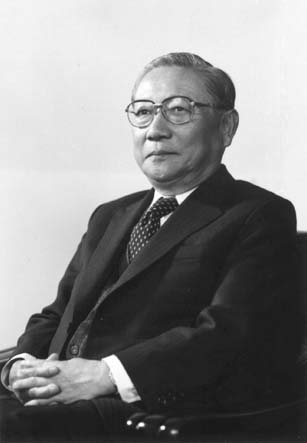
But this article isn’t about those Suzukis. For a very short time in the early 1950s, a company existed called Suzuki Kōgaku Kōgyō K.K. which was named after Mr. Ryohei Suzuki.
Suzuki was a well respected lens designer who as early as 1933 had been working for Konishiroku creating lenses for use in consumer cameras and also by the Japanese military. Although I could find no mention of any specific lenses or projects he was involved in, Konishiroku’s Hexar lenses were already well regarded so it’s plausible that he was involved in some capacity in their construction.
After World War II, Konishiroku, along with every other Japanese optical company was in disarray. Damages to factories from US bombing raids, disruptions in raw materials and energy, and a mandate by US occupation forces to restrict industry meant that camera and lens production would come to a halt. Within a couple years, some companies like Canon, Mamiya, and Nicca resumed producing cameras and lenses for export to help generate income for Japan’s economy.
Around 1948, Asahi Kogaku, who prior to the war was one of Japan’s largest lens makers, was re-established as Asahi Optical Company, Ltd. and led by Mr. Saburo Matsumoto who sought to expand the company’s portfolio to include photographic cameras and build Japan’s first 35mm Single Lens Reflex camera. With limited resources, Matsumoto reached out to his colleague Ryohei Suzuki who he had met while producing lenses for Konishiroku and asked if he would help build an all new 35mm SLR.
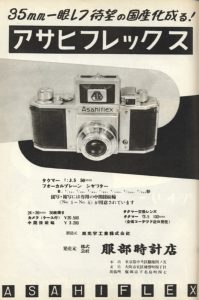
With no experience in building an SLR and with very limited access to German designs which were being developed around the same time, Matsumoto, Suzuki, and a third man named Nobuyuki Yoshida got to work on Asahi’s SLR. In May 1951, the first prototype, called the Asahiflex made it’s debut. The camera had a compact body that was similar in size and layout to the Leica rangefinder, a reflex mirror, waist level finder, and new M37 screw mount, the Asahiflex impressed Saburo Matsumoto so much that he ordered it to go into production immediately.
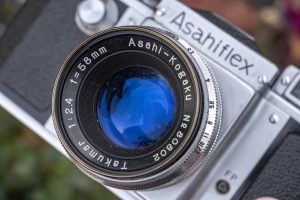
Initial sales were slow, but eventually the Asahiflex would generate excitement and become a success. While working on the Asahiflex, Ryohei Suzuki was responsible for a variety of the Asahiflex’s lenses. Branded as “Takumar”, the first lenses were produced in 1952 and started with a 4-element 50mm f/3.5 in Asahiflex mount and would expand to include a faster 5-element 58mm f/2.4 Takumar.
While still an Asahi employee, Ryohei Suzuki had ambitions to produce his own camera and around 1953 would form his own company called Suzuki Kōgaku Kōgyō K.K. The company’s first, and only, camera would be a medium format rangefinder camera called the Press Van that shot 6cm x 6cm images on 120 roll film.
Although folding 6×6 cameras were very popular in Japan at this time, the Press-Van was a high end model, featuring a coupled rangefinder, native support for 35mm film, and it came with an Asahi Takumar lens, something not seen on any other camera of it’s kind. It is interesting to me that Asahi would not offer a medium format camera until 1969, a decade and a half after the Press Van, suggesting the company didn’t initially have any interest in medium format. Did Asahi have plans to produce a 6×6 folder that were scrapped and later picked up by Suzuki, or was this a pet project of his all along, and he just used his access to Asahi to get the lenses for it?
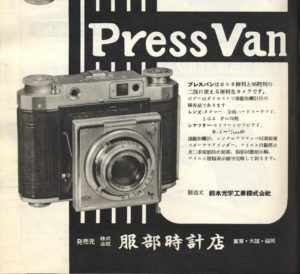
The Press Van does not appear to have been sold outside of Japan, as the only advertisement I could find for it was the one to the left from a 1954 issue of the Asahi Camera Yearbook. No price is mentioned, but compared to other cameras sold around the time, it would have been a premiere model, which suggests it also had a premiere price.
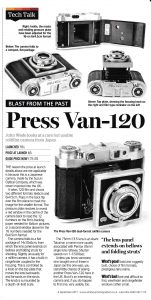
A year after it’s release, an updated model called the Press Van-120 was available. The camera gained support for a 4.5cm x 6cm mask, but lost both support for 35mm film and the automatic exposure counter, instead relying on twin red windows on the back of the camera. Whether or not the simpler Press Van-120 was sold concurrently as a discounted model, or whether there were production difficulties of the more advanced original model is not clear.
In my research for this article, I found very little about the Press Van or Suzuki Kōgaku Kōgyō K.K, as details beyond what I’ve already shared here are scarce. One of my best resources is Koichi Sugiyama’s Collector’s Guide To Japanese Cameras and even that had very little info.
There was at least one other Japanese optical company with the name “Suzuki” that produced a line of very cheap cigarette lighter cameras, but I strongly doubt they are related. I am not even certain if Ryohei Suzuki ever left Asahi to form his new company, or if he did it on the side. If he did leave, did he go back to Asahi after the Press Van-120 was made, or did he do something else?
This short bio of Suzuki suggests that he was directly involved with the design of several M42 mount Takumar lenses which wouldn’t have been produced until the first Pentax model was made in 1957, so if that’s true then he definitely worked there after the last Suzuki camera was made.
The Press Van is a really well built Japanese folding camera with an excellent lens, coupled rangefinder, automatic frame counter, and built in support for 35mm film, but like many other small Japanese optics companies, would be the company’s only product. A huge number of these smaller Japanese companies would come and go, releasing only a small handful of models.
Today, I doubt many people have ever heard of the Suzuki Press Van. I know I didn’t until this one was offered to me. I have to imagine that there are some Japanese collectors who seek out one of the many obscure models like this produced during the mid 20th century, but they are very hard to find, suggesting that when they do show up for sale, they can demand high prices. If, by some chance of fate, you have an opportunity to pick one of these up at anything close to reasonable price, it is definitely a worthwhile model to consider.
My Thoughts
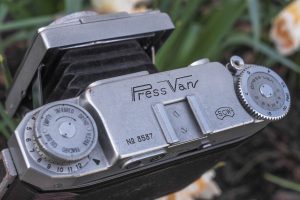
I am incredibly fortunate to have so many awesome readers of this site who continually support me with donations to help offset the cost of not only running and maintaining the site, but also covering the postage costs of acquiring new things to review. While a couple bucks here and there definitely go a long way, a few readers go beyond that and loan me stuff so that I can write about a model I otherwise wouldn’t likely have been able to afford myself. Had it not been for these readers, reviews like the Bell & Howell Foton, Hasselblad XPan, Exakta Real, and Nikon SP would have never been possible.
One such reader, Roger Beal periodically likes to tempt me with new models, many of which I had never heard of previously. The Suzuki Press Van is a camera that I had never heard of until Roger asked if I wanted to review. While any loaner is exciting, to get one from a company that I knew nothing about made the prospect of this uncommon camera even more interesting.
I was ready to accept Roger’s package, but there was a catch. He didn’t have the camera in his possession. It turns out that it was in New Zealand, getting a full CLA from none other than Chris Sherlock of retinarescue.com.
Once the camera was completed, it made it’s long inter-continental journey back to Roger and then to me. As I had expected from anything that Chris touches, the Press Van worked perfectly. It was like handling a brand new 68 year old camera. While working on Roger’s camera, Chris made a series of videos showing the work he did on it. Here is one of Chris’s videos for this exact camera when he had it.
The Suzuki Press Van is not a lightweight camera. The only other 6×6 folding camera that comes close in weight is the KMZ Iskra which tops the Press Van by a mere 16 grams making them both two of the heaviest cameras of this style ever made.
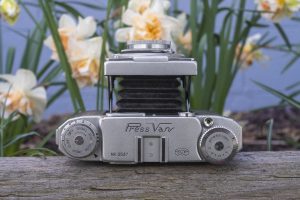
The top plate of the Press Van has a clean, almost screw mount Leica-esque look to it due in large part to the raised platform for the separate rangefinder and viewfinder windows.
On the left is the combination film advance knob with built in exposure counter below it. On top of the knob is a film reminder dial, but this being an unmetered camera, each of the film types listed don’t have any function in the camera.
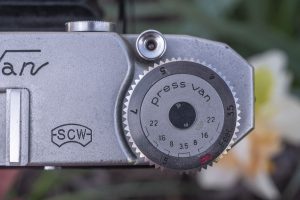
Over to the right where you’d normally see a film advance knob on a 35mm camera is the Press Van’s focusing wheel. Unlike lesser folding cameras in which focus is accomplished via a rotating front element or group, or even slightly more advanced models with a focusing helix, rotating this dial on the Press Van moves the entire front lens board, shutter, lens, and all, forward and back. Compared to the Mamiya Six which was another Japanese 6×6 folding camera with a focusing wheel, the Press Van’s is both easier to use as you can grip the entire wheel, but also simpler than the Mamiya’s solution which moves the film plane.
Although I very much like focusing the Press Van, one minor nitpick to the first time user is the wheel has no index mark to show what distance you have selected. You just have to assume that the rear most position, immediately below the number 3.5 on the depth of field scale is the chosen distance. Using the previous image as an example, the camera is focused about halfway between 15 feet and infinity.
Finally, above and to the left of the focusing wheel is the cable threaded shutter release button. The location of this button falls naturally where my right index finger would be, making for a very comfortable shooting experience.
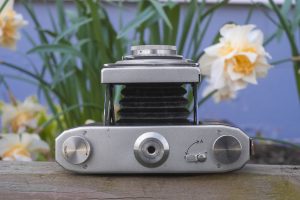
Flip the camera over and you’ll notice a word that doesn’t appear on any other 6×6 folding camera. Rewind.
One of the most distinct features of the original Press Van is it’s ability to shoot regular 35mm film in the camera using a mask and spool adapter that would have come with it when it was new. Sadly, my copy didn’t have these parts, so I couldn’t test it.
With 35mm film in the camera and the spools correctly attached, a small key in the bottom of the roll film post allows you to rewind the film at the end of a roll, but when with a 120 spool in the camera, this knob doesn’t do anything. The presence of an Advance and Rewind lever is there seemingly to reverse the film transport like in a regular 35mm camera, but playing with the camera without the adapter, both knobs on the bottom of the camera turn in both directions regardless of the position of this lever, so I am not sure exactly how it works.
In the center of the bottom plate is the 1/4″ tripod socket which is raised above the bottom plate, but not high enough to equal the height of both the 35mm advance and rewind knobs, so when the camera is sat down on a flat surface, the tripod socket does not touch the surface.
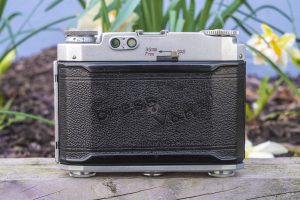
The back of the camera has a large embossed Press Van logo and the eye pieces for both the camera’s coupled rangefinder and optical viewfinder. You must first use the rangefinder on the left for focusing, and then move your eye to the right for composing your image. This is very much like other dual window rangefinders like the Leica and the Argus C-series.
To the right of the viewfinder is a switch for activating the camera’s 35mm mode. Moving the slider to the 35mm position does two things. First, a viewfinder mask slides into the 6×6 viewfinder, showing an approximate of a 35mm image, but it also defeats the exposure counter interlock used for 6×6 images for when you are shooting 35mm film.
Pro Tip: The Suzuku Press Van has a double exposure prevention feature which prevents you from pressing the shutter release twice, even if you manually cock the shutter a second time. If you want to intentionally make a double exposure, after making the first exposure, move the slider on the back to the 35mm/Free position and cock the shutter. You can then double (or more) expose over the same piece of film. When you are done with the exposure, remember to move the slider back to the 6×6 position before turning the film advance knob.
On the side of the film advance knob above the numbers 1-12 for 6×6 film, is a second exposure counter for 1-36 exposures which you can see in the previous image. With the camera in 35mm mode, there is no interlock or stop that prevents you from over advancing the film, so you must be careful with 35mm film to stop at exactly the point where the exposure counter indicates the next exposure.

When shooting 6×6 images, the camera will automatically stop at each of the numbers 1-12 for each exposure. Only when cocking the shutter and pressing the shutter release button will you be able to advance the camera again. The Press-Van does not use any sort of complex film feeler like other medium format cameras like the Rolleiflex or Kodak Medalist in which the camera detects the movement of film to determine the next exposure. Each rotation of this knob moves the film a predetermined amount of space, to ensure you don’t overlap frames.
After the 12th exposure, continuing to rotate the film advance knob will move the exposure counter to a red “F” and you will be able to continue to rotate the knob to roll up the paper trailer on the film. With the exposure counter in this “F” position, the counter will not continue to move until you are ready to install a new roll of film.
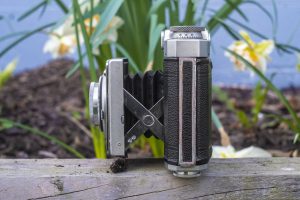
Opening the film compartment requires you to slide down a release latch on the camera’s left side which allows you to swing open the film compartment.
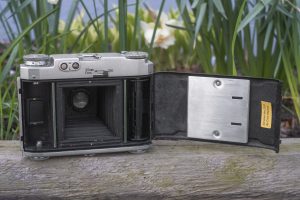
The right hinged film door swings open to reveal a rather ordinary looking 120 roll film compartment. Film transport is from right to left onto regular 120 spools.
A new roll of film is installed on the right by pulling down on the Rewind knob on the camera’s bottom and dropping in a new roll. Move an empty spool to the left side by pulling down on the unlabeled knob on the camera’s bottom and dropping in what is now the take up spool.
After attaching the leader to the take up spool, with the exposure counter still in the “F” position, continue to turn the film advance knob until the start mark on the film’s backing paper lines up with the two white dots above and below the film gate. There is a third red dot in the film plane, but this is only to be used with the 35mm adapter.
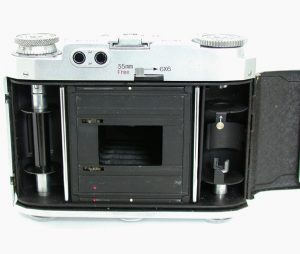
Next, close the door, latch it shut, and then move the film type switch from the 6×6 position to the 35mm position and then back again. Doing this releases the hold on the exposure counter from the “F” position. Do not leave the camera in 35mm mode with 120 film loaded as it will defeat the automatic stop feature at each of the numbered 1 through 12 exposures.
With the film loaded, the door shut, and the film type switch back to the 6×6 position, rotate the film advance knob until you reach the number 1 on the exposure counter at which point the advance knob should lock. You must first manually cock the shutter using the lever on the shutter before pressing the shutter button, which will both fire the shutter and also release the film advance knob, so you may then turn it to the next exposure, and so on.
Pro Tip: The Press-Van’s film transport is likely to be confusing for the first time user, but thankfully, the entire process can be practiced with the film compartment open. You do not need to have film in the camera to see it in action, so if you have one of these cameras and are struggling to understand how it works, try it out with the door open and you can see how everything moves, even without film.
The Press Van has separate rangefinder and viewfinder windows. The rangefinder takes a cue from cameras like the Leica in that the left rangefinder window is magnified approximately 1.5x showing a larger than life circular spit image which takes up almost the entire rangefinder window. This makes achieving precise focus extremely easy as vertical images such as the utility pole in the image below are very easy to see. This example had a very clean viewfinder with excellent contrast, I believe that even dirty examples would still be easy to use as it is so easy to line up the rangefinder.
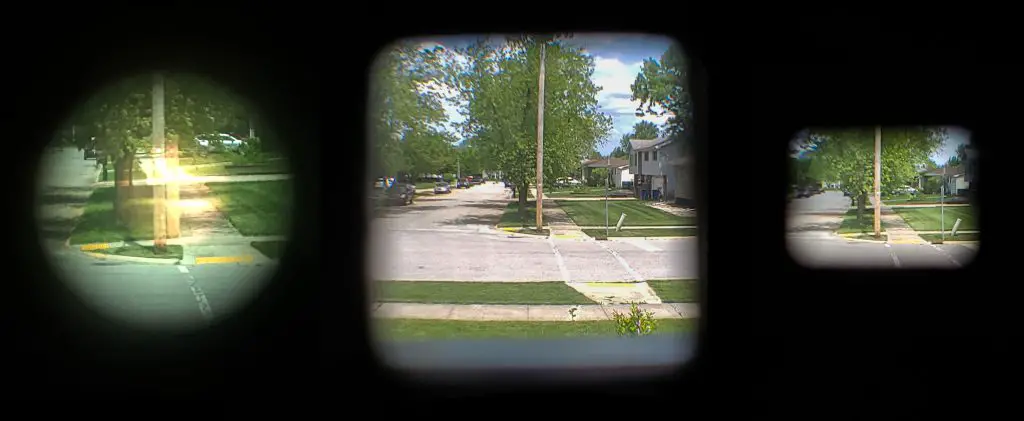
This particular Press Van, having been recently serviced by Chris Sherlock, had both perfectly clean and accurate rangefinder and viewfinder windows. The circular rangefinder has a pink on blue coincident image patch that is very easy to see. The main viewfinder shows both a square image when the camera is in 6×6 mode, and a smaller rectangle when the camera is in 35mm mode. In the composite image above, I show three images of the rangefinder, 6×6 viewfinder, and 35mm viewfinder. In use, you cannot see all of these together at the same time.
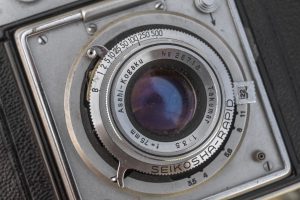
The Seikosha-Rapid shutter is a rim set design like that found on many other Japanese and German cameras of the era. Shutter speeds are changed via the chrome ring around the edge from 1 second to 1/500 plus Bulb, and f/stops are chosen with a metal tab with a square hole in the center opposite of the shutter speeds.
The shutter is not coupled to the film transport, so you must manually cock the shutter before each exposure can be made via the lever above the shutter speeds. A flash sync port is near the bottom right corner of the lens board, and finally, in the upper right corner of the lens board is the release catch for extending the bellows. The Suzuki Press Van does not have a self timer.
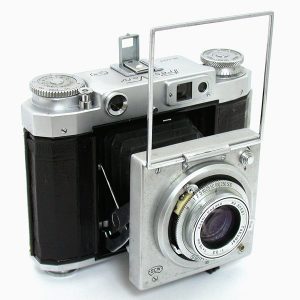
One final feature is a flip up wire frame finder which was intended to be used as a sort of “sports finder” for fast action shots. Originally, the camera would have come with a smaller hinged viewfinder that clipped onto the accessory shoe which would help you frame your image using the larger frame, but I did not have access to that piece. Without it, it’s location directly on the lens board means that when holding the camera in front of you, the bottom part of the frame is blocked by the top of the camera, limiting it’s use. I am uncertain of how many people would actually use the wire frame finder, and this feature’s disappearance on the later Press Van-120 suggests few did.
Without loading film into the Press Van, it is quite clear that this was a special camera, created by people who wanted to include as many features as possible to produce something unlike competing models on the market. With features like dual 120/35mm film modes, a coupled rangefinder, top plate focus with moving lens board, an automatic exposure counter, fast action sports finder, and an excellent Takumar lens and Seikosha shutter, the Press Van is definitely unlike anything else ever made.
My Results
My first roll through the Press Van was fresh Ilford 400 and I took it on a cloudy day up to Mackinac City, Michigan which is a favorite place of mine to shoot the historic bridge, along with the vacated tourist area around it. I found the dreary lighting of cloudy northern Michigan near the end of winter to be perfect for a 400 speed black and white film.
Pleased with the results from that first roll, I took the Press Van out again, this time with some fresh Kodak Ektar 100 and visited the train station/downtown era of Flossmoor, IL.
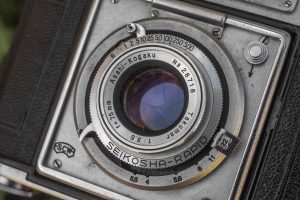
The Press Van performed about as well as you might expect a medium format camera with a Takumar lens would, which is to say, awesome! Ryohei Suzuki was a very talented lens designer as many of his early Takumar lenses are highly regarded today as being some of the best ever made, and the 75mm f/3.5 Takumar on the Press Van is no exception.
In fact, I can’t understand why more medium format cameras didn’t have these lenses. I could imagine a whole legion of Rolleiflex clones or 2×3 sheet film cameras benefiting from medium format Takumar lenses. Sure, Asahi Optical would eventually get into the medium format game in 1969 with the Pentax 67 system, but this much earlier Suzuki hints at what could have been had the company jumped in sooner.
Maybe it was for the best though, as if the company put energy into medium format cameras, perhaps they wouldn’t have had as much time to perfect their Pentax lineup.
Whatever the case, the Press Van was a very well built camera loaded with features and an excellent lens. The rangefinder works very well, the top plate focus works very well, and although I never tried it, support for 35mm was a nice way of having your cake and eating it too.
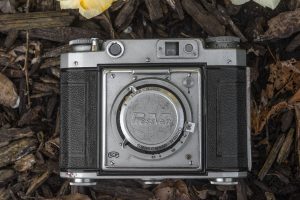
Perhaps a missed opportunity for the Press Van lies in it’s focusing system in which a wheel moves the entire front lens standard backwards for infinity and forward for minimum focus, would have been to allow it to focus closer than 3.5 feet. Since moving the shutter and lens forward reduces the focus distance, Suzuki could have given the Press Van close focus macro capabilities by allowing it to extend the lens much farther than other 6×6 folding cameras. While it’s not usual for 6×6 folding cameras to have macro capabilities, it is clear Suzuki did not feel constrained by what everyone else was doing when designing this camera.
One area of the camera I struggled with was the film advance. With both rolls, I found that loading the film with the arrows pointing to the white dots and then advancing the film from there, got it to the number 1 exposure too soon. This caused me to lose my first shot on both rolls, and also hit the 12th exposure still with room for one more at the end. I can’t be sure if this is just how this camera is, or if it’s a sign of the camera’s age. The fact that it recently had a CLA suggests it’s user error so I won’t hold it against the camera.
Other than maybe being a bit heavy, I don’t have any complaints or nitpicks of the camera as this truly is one of the better 6×6 folders I have ever used. I am really happy not only that Roger sent me this camera for review, but also that it was serviced by Chris Sherlock, assuring a perfectly working example of a fantastic camera.
Normally when I finish up a glowing review like this, I recommend anyone reading this go out and look for one themselves, but the rarity of these cameras will make that very difficult. I likely won’t ever have one of these in my permanent collection, as I suspect a large number of people reading this won’t either, but if you do decide to look, be forewarned that I’ll be looking too! 🙂
Related Posts You Might Enjoy
External Links
http://camera-wiki.org/wiki/Press_Van
https://www.photrio.com/forum/threads/suzuki-optical-co-press-van.174678/
https://www.hayatacamera.co.jp/monthlyphoto/2016-11-press-van-with-takumar-75mmf3-5/ (in Japanese)

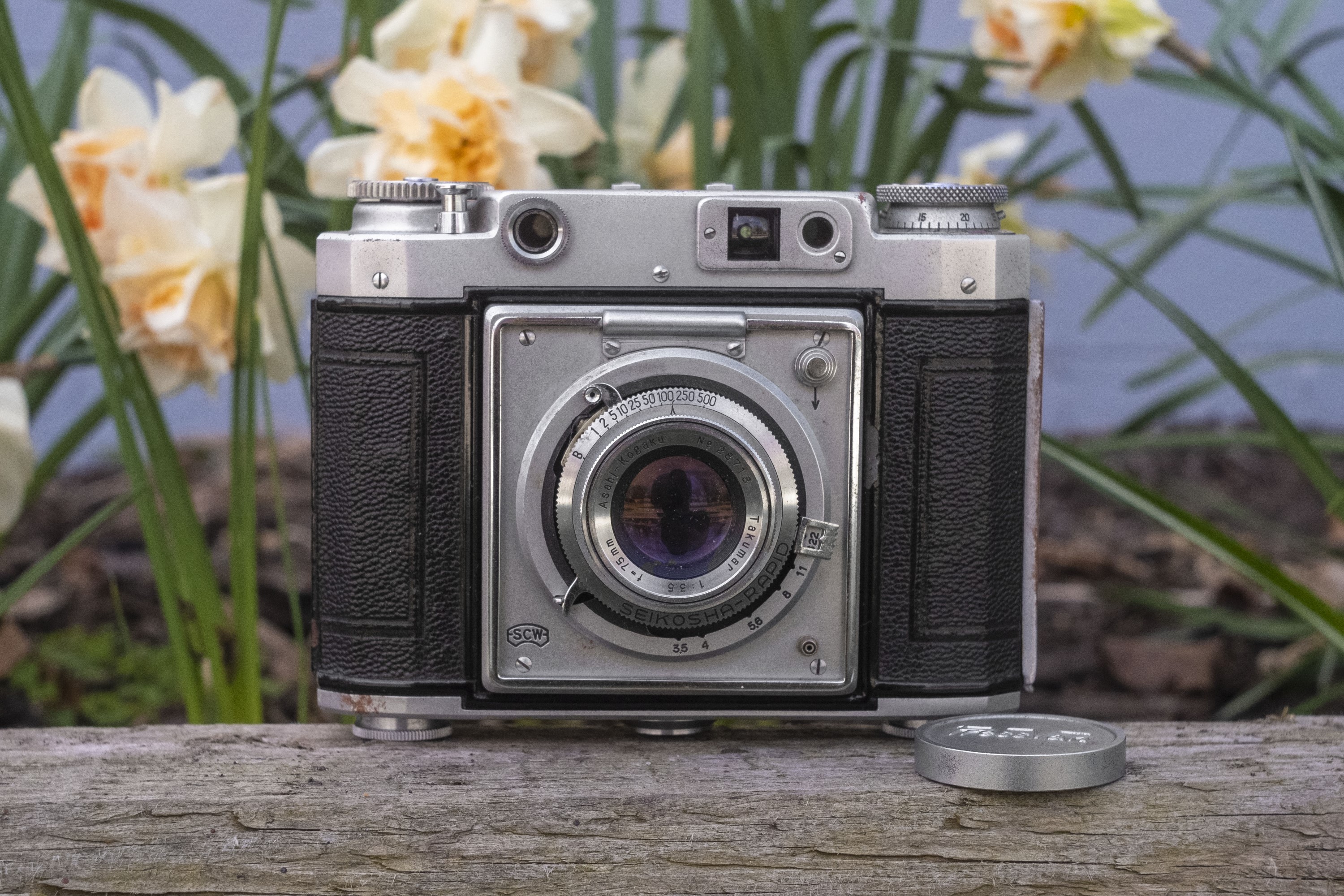
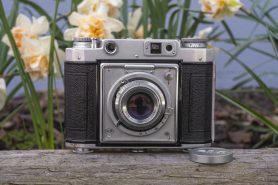
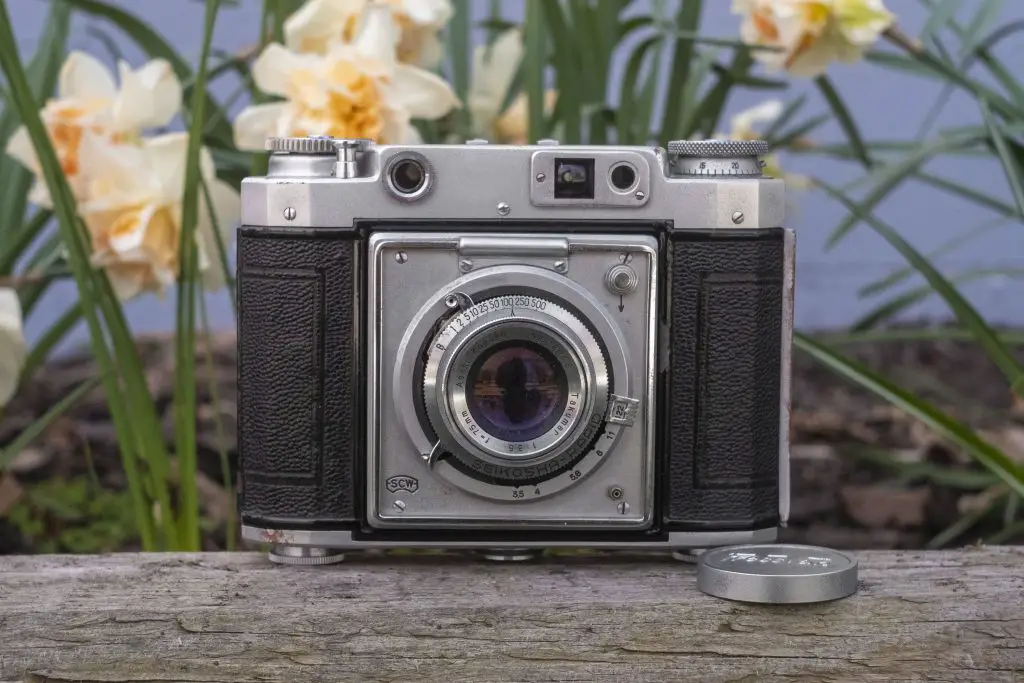





















It’s a fantastic camera. I don’t know if you know there is foot hidden on the right side, so you can put the Press Van on table with the front plate open.